Description
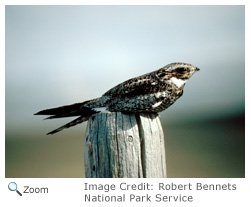 The common nighthawk is not really a hawk. It is actually a member of the nightjar family. The nightjar family includes the whip-poor-will and the common poorwill. The common nighthawk is a jay-sized bird about 10 inches in length. It has mottled grayish-brown feathers, a long forked tail, and long pointed wings with a broad white wing bar. The common nighthawk is not really a hawk. It is actually a member of the nightjar family. The nightjar family includes the whip-poor-will and the common poorwill. The common nighthawk is a jay-sized bird about 10 inches in length. It has mottled grayish-brown feathers, a long forked tail, and long pointed wings with a broad white wing bar.
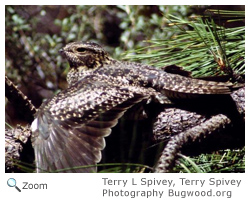 The common nighthawk has a large mouth with bristles that help it catch insects. Males have a white throat patch and a white tail bar. Females have a light brown or cinnamon colored throat patch and no tail bar. The common nighthawk has a large mouth with bristles that help it catch insects. Males have a white throat patch and a white tail bar. Females have a light brown or cinnamon colored throat patch and no tail bar.
Range
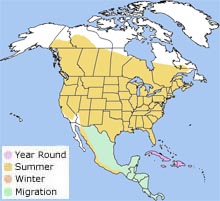 The common nighthawk breeds from the Yukon east to Nova Scotia and south through most of the United States, except Alaska and Hawaii. It winters in South America. The common nighthawk is an endangered species in New Hampshire. Scientists believe this may be due to nesting habitat loss and increased use of insecticides that kill the insects that the common nighthawk needs to survive. The common nighthawk breeds from the Yukon east to Nova Scotia and south through most of the United States, except Alaska and Hawaii. It winters in South America. The common nighthawk is an endangered species in New Hampshire. Scientists believe this may be due to nesting habitat loss and increased use of insecticides that kill the insects that the common nighthawk needs to survive.
Habitat
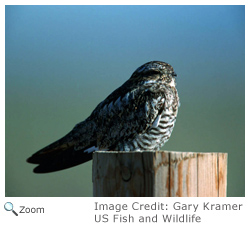 The common nighthawk is found in open woodlands, clearings, and fields. It is also found in towns and cities. The common nighthawk is found in open woodlands, clearings, and fields. It is also found in towns and cities.
|
|
Diet
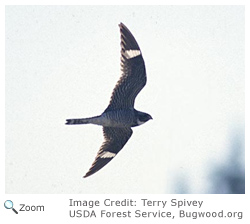 While in flight, the common nighthawk catches flying insects like flying ants, mosquitoes, moths, and grasshoppers. It feeds at dawn, dusk, and at night. It sometimes feeds during the day, especially if it is overcast. It is sometimes called the mosquito hawk! While in flight, the common nighthawk catches flying insects like flying ants, mosquitoes, moths, and grasshoppers. It feeds at dawn, dusk, and at night. It sometimes feeds during the day, especially if it is overcast. It is sometimes called the mosquito hawk!
Lifecycle
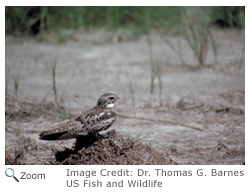 Mating season runs from April through July. The nighthawk doesn't build a nest. The female lays from 1-3 eggs on the ground in an open gravely or lightly vegetated area. In cities and towns, she often lays her eggs on a flat gravel-covered roof. The female incubates the eggs for about 19 days. The chicks can move about on their own shortly after birth, but they are fed by both their parents for about a month. They start to fly when they are around 23 days old. Mating season runs from April through July. The nighthawk doesn't build a nest. The female lays from 1-3 eggs on the ground in an open gravely or lightly vegetated area. In cities and towns, she often lays her eggs on a flat gravel-covered roof. The female incubates the eggs for about 19 days. The chicks can move about on their own shortly after birth, but they are fed by both their parents for about a month. They start to fly when they are around 23 days old.
Behavior
The common nighthawk has adapted to city life. Flat roofs make good nesting spots. Baseball fields and other open areas that have artificial lights attract insects, making them good hunting spots for the common nighthawk.
|

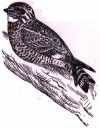


 The common nighthawk breeds from the Yukon east to Nova Scotia and south through most of the United States, except Alaska and Hawaii. It winters in South America. The common nighthawk is an endangered species in New Hampshire. Scientists believe this may be due to nesting habitat loss and increased use of insecticides that kill the insects that the common nighthawk needs to survive.
The common nighthawk breeds from the Yukon east to Nova Scotia and south through most of the United States, except Alaska and Hawaii. It winters in South America. The common nighthawk is an endangered species in New Hampshire. Scientists believe this may be due to nesting habitat loss and increased use of insecticides that kill the insects that the common nighthawk needs to survive. 

